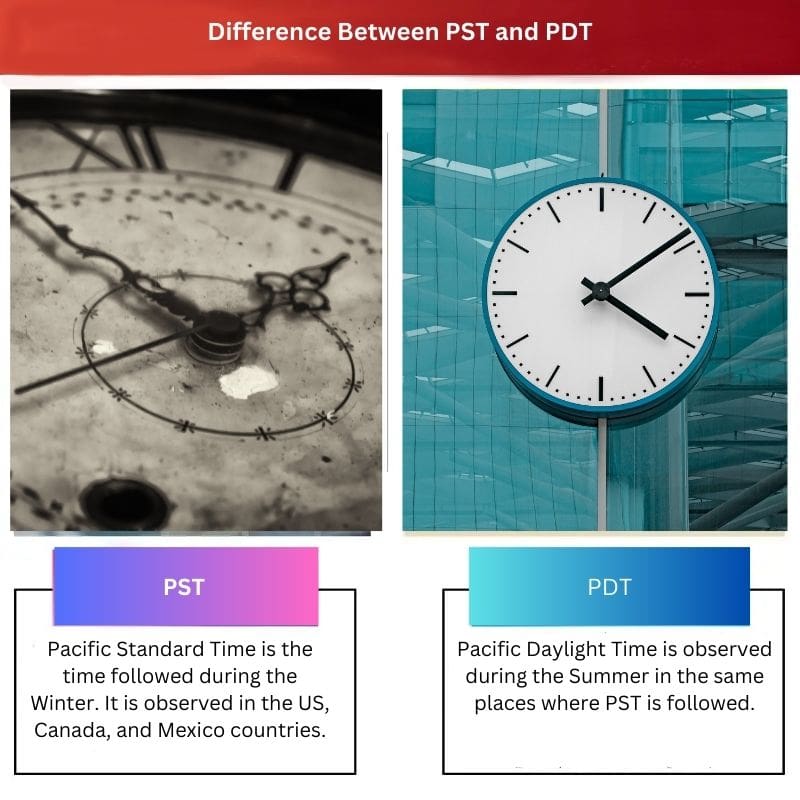The Pacific Time Zone is one of the 25 available zones currently covering parts of the United States of America, Canada, and Mexico.
These places have their standard time calculated as Universal Time – 8 Hours. Universal Time is also called Coordinated Universal Time, the successor of GMT.
Key Takeaways
- PST (Pacific Standard Time) is the time zone used in parts of the United States and Canada when observing standard time, while PDT (Pacific Daylight Time) is the time zone used in the same region during daylight saving time.
- PST is eight hours behind Coordinated Universal Time (UTC-8), while PDT is seven hours behind Coordinated Universal Time (UTC-7).
- The transition between PST and PDT occurs twice a year: clocks are set forward one hour in the spring to observe daylight saving time (PDT) and set back one hour in the fall to return to standard time (PST).
Difference Between PST and PDT
The difference between PST and PDT is the standard time followed during November and mid-March, while PDT is followed from mid-March to November.

In short, PST is followed during the winter months, and PDT is followed during the summer months of a calendar year. PDT is kept one hour ahead of the PST to observe longer days.
PST is followed in a particular season, and another time zone exists that is 7 hours behind the Universal Time called PDT; this is observed in a certain period apart from PST.
PST and PDT are followed one after the other in a calendar year. PST surpasses the next calendar year, while PDT is observed in the same year.
Comparison Table
| Parameter of Comparison | Pacific Standard Time | Pacific Daylight Time |
|---|---|---|
| Definition | Pacific Standard Time is the time followed during the Winter. It is observed in the US, Canada, and Mexico countries. | Pacific Daylight Time is observed during the Summer in the same places where PST is followed. |
| Time Frame | PST is followed from Early November to Mid March | PDT is observed from Mid March to Early November |
| UTC Difference | 8 hours behind UTC | 7 Hours Behind UTC |
| Time Difference | It is the standard time, and it remains the same. | Time is kept one hour ahead of PST. |
| Benefits | Shorted Winter Days | Longer Summer days and Energy shall be conserved. |
General Information
This table serves as a brief yet comprehensive primer on PST and PDT. It includes basic defining characteristics such as their full names, abbreviations, their respective offsets from UTC, and the regions where they are commonly used. Additionally, it provides a general guideline on the time of year each zone is used, shedding light on their cyclical nature.
| Parameter of Comparison | PST | PDT |
|---|---|---|
| Full Name | Pacific Standard Time | Pacific Daylight Time |
| Abbreviation | PST | PDT |
| Offset from Coordinated Universal Time (UTC) | UTC-8 | UTC-7 |
| Regions Covered | US and Canada (in part), Mexico (Tijuana) | US and Canada (in part), Mexico (Tijuana) |
| Time of Year Used | Standard Time (Generally Nov – Mar) | Daylight Saving Time (Generally Mar – Nov) |
Time Differences
This table effectively visualizes the time difference between PST and PDT at key points in a 24-hour cycle. This data can be particularly useful for planning and understanding the shift between these two time zones during the daylight saving transition.
| Parameter of Comparison | PST | PDT |
|---|---|---|
| Midnight | 00:00 | 01:00 |
| 6 AM | 06:00 | 07:00 |
| Noon | 12:00 | 13:00 |
| 6 PM | 18:00 | 19:00 |
| 11 PM | 23:00 | 00:00 |
International Comparisons
This table can prove instrumental for those coordinating across various international time zones. Users can better manage international scheduling and understand the relative time differences by showcasing how PST and PDT align with key global time zones like UTC, EST, GMT, CET, and IST.
| Parameter of Comparison | PST | PDT |
|---|---|---|
| UTC (Coordinated Universal Time) | UTC-8 | UTC-7 |
| EST (Eastern Standard Time) | UTC-5 (PST +3 hours) | UTC-4 (PST +3 hours) |
| GMT (Greenwich Mean Time) | UTC+0 (PST +8 hours) | UTC+0 (PDT +7 hours) |
| CET (Central European Time) | UTC+1 (PST +9 hours) | UTC+2 (PDT +9 hours) |
| IST (Indian Standard Time) | UTC+5:30 (PST +13:30 hours) | UTC+5:30 (PDT +12:30 hours) |
Impact on Daily Activities
While time zones are discussed abstractly, their impact on daily life is tangible. This table presents a practical perspective by illustrating how the transition between PST and PDT can affect typical daily activities such as sunrise and sunset times and traditional work hours.
| Parameter of Comparison | PST | PDT |
|---|---|---|
| Sunrise (Approximately) | 7 AM | 6 AM |
| Workday Start (Typically) | 9 AM | 8 AM |
| Noon Break | 12 PM | 1 PM |
| Workday End (Typically) | 5 PM | 6 PM |
| Sunset (Approximately) | 5 PM | 8 PM |
Legislation and Adoption
It’s important to consider their legislative and regional adoption contexts to understand why and how PST and PDT are used. This table summarizes key legislative acts underpinning the use of these time zones and their adoption across different regions in the USA, Canada, and Mexico.
| Parameter of Comparison | PST | PDT |
|---|---|---|
| Adoption in the USA | All year in Arizona, part of Nevada, part of Idaho, and Oregon | Part of the year (summer months) in California, Washington, most of Oregon, part of Nevada, and part of Idaho |
| Adoption in Canada | All year in parts of British Columbia | Part of the year (summer months) in most of British Columbia |
| Adoption in Mexico | All year in Baja California | Not formally adopted |
| Legislation in USA | Uniform Time Act of 1966 | Energy Policy Act of 2005 |
| Legislation in Canada | Time Act | Time Act |
What is PST?
Pacific Standard Time is the time zone followed in some parts of Canada, the United States, and Mexico. It is the standard time that is observed during the Winter season.
Ideally, the months that they follow the PST are from Early November of every year to the Mid of March of the following year. In Winter, the PST is 8 hours behind Universal Time.
It is observed that Pacific Standard Time is used in Winter to reduce the day. There are places in the countries mentioned that completely follow the PST.
In Canada, only Yukon is entirely under the Pacific Time Zone. Further, the Northwest Territories and British Columbia partially follow, while the other parts follow the Mountain Zone.
In the United States of America, two states completely fall under Pacific Standard Time. They are California and Washington. As with parts of Canada, a few states in the US are also split among PST and Mountain Time Zone.
History of PST
Pacific Standard Time (PST) is the time zone that covers parts of western Canada, the western United States, and western Mexico. Specifically, this time zone serves as the standard time in these locations, also known as Pacific Standard Time (PST). PST is 8 hours behind Coordinated Universal Time (UTC-8) and is observed during the winter months, from November through March.
Throughout history, the need for uniform timekeeping led to the establishment of time zones, which helped coordinate trade, transportation, and communication. Before the implementation of time zones, local solar time was used, which differed between nearby cities due to their geographical positions. In the late 19th century, the introduction of railways led to the creation of a standardized time for vast regions, and the Pacific Standard Time Zone emerged as one of them to synchronize activities across the western part of North America.
Regions under PST
The Pacific Standard Time (PST) is observed in various regions across Western Canada, the Western United States, and Western Mexico. In the United States, states that fall under PST include:
- California
- Part of Idaho
- Nevada
- Most of Oregon
- Washington
Meanwhile, in Canada, the provinces and territories using PST are:
- British Columbia
- Yukon

What is PDT?
Pacific Daylight Time is the time zone followed during the Summer months in the places where PST is followed. It is again observed in Canada, the United States, and Mexico.
PDT is the other way around PST in following the time zone. It begins in March every year and ends in the Early November of the same year.
The Energy Policy Act of 2005, passed by the US government, altered the PDT dates that were followed for many years. The policy states to change the time one hour ahead on the second Sunday of March every year.
Subsequently, PDT is set back to PST on the First Sunday in November. Earlier, it was 1st Sunday in April to the last Sunday in October.
History of PDT
Pacific Daylight Time (PDT) is the time zone used in the same regions as PST during daylight saving time. This time change occurs from March through November in the United States, Canada, and Mexico. PDT is 7 hours behind Coordinated Universal Time (UTC-7) and was established to use daylight during the longer summer days better.
The concept of daylight saving time dates back to the early 20th century when several countries, including the United States, recognized the benefits of adjusting time to make the most of the available daylight. The implementation of PDT aimed to save energy by reducing the need for artificial lighting and heating. Over time, daylight saving time has evolved, with changes in start and end dates to better align with seasonal variations in daylight hours.
Regions under PDT
Pacific Daylight Time (PDT) is observed during daylight saving time in the same regions that use PST. This means California and parts of Nevada are under PDT in the United States. Additionally, all the regions mentioned above for PST switch to PDT during daylight saving time, ensuring that daylight hours are better utilized in the evening.
Remember, PDT is one hour ahead of PST, so when it’s noon PST, it’s 1 p.m. PDT. Adjusting your clocks accordingly during the transition between PST and PDT can help you stay in sync with the local time and any events or activities you may have planned.

Main Differences Between PST and PDT
- The two time zones belong to the exact locations. However, the main difference between PST and PDT is, PST is followed during Winter while PDT is followed during Summer.
- Pacific Standard Time begins in Early November of every year; it continues till the middle of March of the following year. Pacific Daylight Time starts in the Mid of March and extends till early November.
Time Conversion: PST to PDT
When you need to convert the time between Pacific Standard Time (PST) and Pacific Daylight Time (PDT), knowing the key differences and how they affect your scheduling is essential. It’s important to recognize that PST is one hour behind PDT.
To convert from PST to PDT, you simply need to add one hour to the PST time. For example, if it is 9:00 AM in PST, it would be 10:00 AM in PDT. On the other hand, to convert from PDT to PST, you subtract one hour. So if it is 4:00 PM in PDT, it would be 3:00 PM in PST.
Keep in mind the specific periods during the year when the time changes happen:
- Daylight Saving Time begins (switching from PST to PDT): on the second Sunday of March
- Daylight Saving Time ends (switching from PDT to PST): on the first Sunday of November
You can use online tools like World Time Buddy or Savvy Time to help you with the time conversion. These platforms have user-friendly interfaces that simplify the process and accommodate daylight-saving time changes. You’ll get an accurate conversion between PST and PDT by entering the location or timezone.
When scheduling meetings or conference calls, it’s important to consider the convenience of all parties involved. If you are in PST, the most suitable time for a meeting would be between 9:00 AM and 5:00 PM. In PDT, this corresponds to a comfortable working time between 10:00 AM and 6:00 PM. Doing so helps ensure everyone’s availability and lesser chances of conflicts or misunderstandings due to time differences.
Daylight Saving Shift
Shift from PST to PDT
During daylight saving time, you’ll need to move your clocks forward by one hour. This transition occurs in mid-March, when the clock is set to move from Pacific Standard Time (PST, UTC-8 hours) to Pacific Daylight Time (PDT, UTC-7 hours). This change is meant to provide more evening daylight and save energy. The specific date of this shift can vary each year, so it’s essential to keep an eye on the calendar.
To adjust from PST to PDT, remember the saying “spring forward, fall back.” In the spring months, you will advance your clock by one hour. For example, if it is 1:59 am PST, you would set your clock to 3:00 am PDT.
Shift from PDT to PST
In mid-November, daylight saving time ends, and you’ll need to move your clocks back by one hour to revert to Pacific Standard Time (PST, UTC-8 hours). This transition is known as “falling back” and happens on the first Sunday of November at 2:00 am.
When changing from PDT to PST, you will set your clock back one hour. So, if it is 1:59 am PDT, you would adjust your clock to 1:00 am PST. This transition will give you an extra hour of sleep and revert to the standard time used throughout the winter months.
During these time changes, adjusting your schedules, appointments, and daily routines is essential. By being aware of the shift between PST and PDT, you can ensure that you stay on track and maintain clear communication with others who may be affected by these transitions in the Pacific Time Zone.


This article provides a clear and comprehensive understanding of the differences between PST and PDT, as well as the impact of these time zones on daily activities. It is very informative and useful for anyone needing to coordinate across different regions or understand the variations in time observed during different seasons.
I agree, the tables and details provided offer a high level of precision and clarity. Very well done.
Absolutely, the breakdown of international comparisons is particularly helpful for those managing schedules across different global regions. This article is a valuable resource.
The article effectively highlights the cyclical nature of PST and PDT, particularly in the context of their time of year used. The comparison tables are especially useful for visualizing their differences at a glance.
The visual comparisons provided in the tables are instrumental in helping readers grasp the distinctions between PST and PDT. It’s a robust presentation of the differences.
The cyclical nature of these time zones is a key aspect of understanding their usage. The article presents this in a well-structured manner.
The article delivers a comprehensive breakdown of PST and PDT, and the impact on daily activities. However, it would be interesting to see a lighter, more comical take on these time zones to engage readers in a different manner.
While the article effectively outlines the differences between PST and PDT, it could benefit from a more critical examination of the potential implications of these time zones for various industries or economic activities.
The detailed descriptions and international comparisons serve to broaden the understanding of PST and PDT across different contexts. However, the article could be condensed to deliver a more concise overview.
The legislative and regional adoption of PST and PDT are important elements in understanding these time zones. The article adeptly captures these aspects, contributing to a well-rounded analysis of the topic.
The expansion on the legislative and regional adoption of PST and PDT brings an interesting context to their usage. The impact on daily activities is also well-presented and easy to comprehend.
The real-life applications of this information are highlighted effectively, demonstrating the practical relevance of understanding these time zones.
I appreciate the attention to detail in this article. It provides valuable insights into the timing of daylight transitions and the legislation associated with these time zones.
The general information and detailed comparisons between PST and PDT are enlightening, and the impact on daily activities is an essential consideration that adds practical value to the article.
While the article is indeed informative, it lacks a more critical analysis of the potential drawbacks or limitations of following PST or PDT. It would be beneficial to include a more balanced perspective.
I see your point, Leanne. Including a discussion on the limitations or drawbacks of these time zones would provide a more holistic view of the topic.
Agreed, a consideration of the challenges associated with following PST and PDT would enhance the comprehensiveness of the article.
Despite the informative nature of the article, it could benefit from a more engaging presentation style to further captivate readers. Perhaps incorporating anecdotes or real-life examples would enhance its appeal.